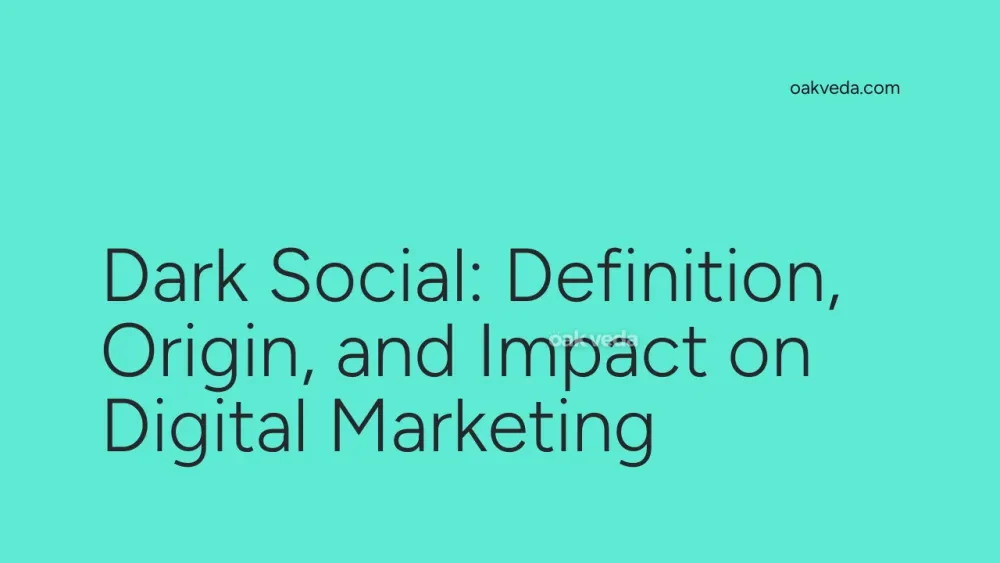
What is Dark Social?
Dark social refers to the sharing of content through private digital channels that are difficult to track using traditional web analytics tools. This phenomenon encompasses various forms of online communication, including messaging apps, email, and private social media messages. The term "dark" doesn't imply anything sinister; rather, it highlights the challenge marketers face in illuminating these hidden pathways of content distribution.
Origin and Development of Dark Social
The concept of dark social was first introduced by Alexis Madrigal in an article for The Atlantic in 2012. Madrigal observed that a significant portion of website traffic seemed to appear out of nowhere, with no clear referral source. As social media and messaging apps have proliferated, the importance of dark social in the digital landscape has only grown.
How Dark Social Works
Dark social operates through various private channels:
- Messaging apps: WhatsApp, Facebook Messenger, and WeChat
- Email: Personal and professional communications
- Private social media messages: Direct messages on platforms like Instagram or Twitter
- Secure browsing: Use of HTTPS links that don't pass referrer information
When users share content through these channels, the recipient's click appears as "direct traffic" in analytics tools, masking its true origin.
Types of Dark Social
While dark social isn't typically categorized into distinct types, it manifests in several forms:
- Link sharing: Sending URLs via private messages or email
- Content copying: Pasting text or images into private conversations
- App-to-app sharing: Using built-in share functions within mobile apps
- Offline-to-online sharing: Verbally sharing a website address that's later typed into a browser
Popular Examples of Dark Social
- WhatsApp sharing: A user sends an interesting article link to a group chat
- Email newsletters: Subscribers forward newsletter content to colleagues
- Instagram DMs: An influencer privately shares a product link with followers
- Slack conversations: Team members exchange work-related resources
Impact of Dark Social on Social Media Culture
Dark social has significantly influenced how people interact online:
- Privacy-focused sharing: Users increasingly prefer private channels for sharing content
- Authentic recommendations: Dark social often involves more genuine, trusted recommendations
- Micro-communities: Formation of small, private groups around specific interests
- Shift in content consumption: Rise in private, curated content feeds vs. public social media timelines
Controversies Surrounding Dark Social
The primary debate around dark social centers on the balance between user privacy and marketing insights. While users value the ability to share content privately, marketers struggle with the lack of visibility into these interactions. This tension has led to discussions about ethical data collection and the future of digital marketing in an increasingly privacy-conscious world.
How Brands and Influencers Use Dark Social
Despite its challenges, savvy marketers are finding ways to leverage dark social:
- Encouraging sharing: Adding "share via messaging" buttons to content
- Creating shareable content: Developing easily copy-pasteable snippets or images
- Utilizing trackable links: Implementing unique UTM parameters for different channels
- Engaging in messaging apps: Developing chatbots or joining relevant groups
- Influencer partnerships: Collaborating with influencers who have engaged private audiences
Future Trends Related to Dark Social
As digital communication evolves, several trends are emerging:
- Advanced attribution models: Development of AI-powered tools to better estimate dark social traffic
- Integration of messaging platforms: Increased focus on marketing within popular messaging apps
- Privacy-centric analytics: New methods for gathering insights while respecting user privacy
- Emphasis on word-of-mouth marketing: Strategies designed to encourage organic, private sharing
FAQs about Dark Social
-
How much traffic comes from dark social? Estimates vary, but some studies suggest that up to 84% of outbound sharing from publishers' sites occurs via dark social.
-
Can dark social be measured? While it can't be fully tracked, techniques like link shorteners, campaign-specific landing pages, and advanced analytics can help estimate dark social traffic.
-
Is dark social the same as dark web? No, they're different concepts. Dark social refers to private sharing on the regular internet, while the dark web involves hidden networks requiring special software to access.
-
How does dark social affect SEO? Dark social can indirectly impact SEO by influencing user behavior and content popularity, even if the traffic source isn't directly visible.
-
What platforms contribute most to dark social? Messaging apps like WhatsApp and Facebook Messenger, along with email, are major contributors to dark social traffic.
In conclusion, dark social represents a significant challenge and opportunity for digital marketers. As private sharing continues to dominate online interactions, understanding and adapting to this phenomenon will be crucial for brands seeking to connect with their audiences effectively. By embracing new technologies and respecting user privacy, marketers can navigate the shadowy waters of dark social and harness its power for meaningful engagement.
You may be interested in:
- Say Less: Definition, Origin, and Impact on Social Media
- @-Me: Definition, Origin, and Impact on Social Media
- Blue Checkmark: Definition, Origin, and Impact on Social Media
- Social Media Manager: Definition, Origin, and Impact
- That Girl: Definition, Origin, and Impact on Social Media
- "It's Whackadoodle Time": Definition, Origin, and Impact

